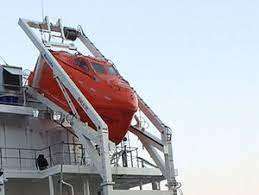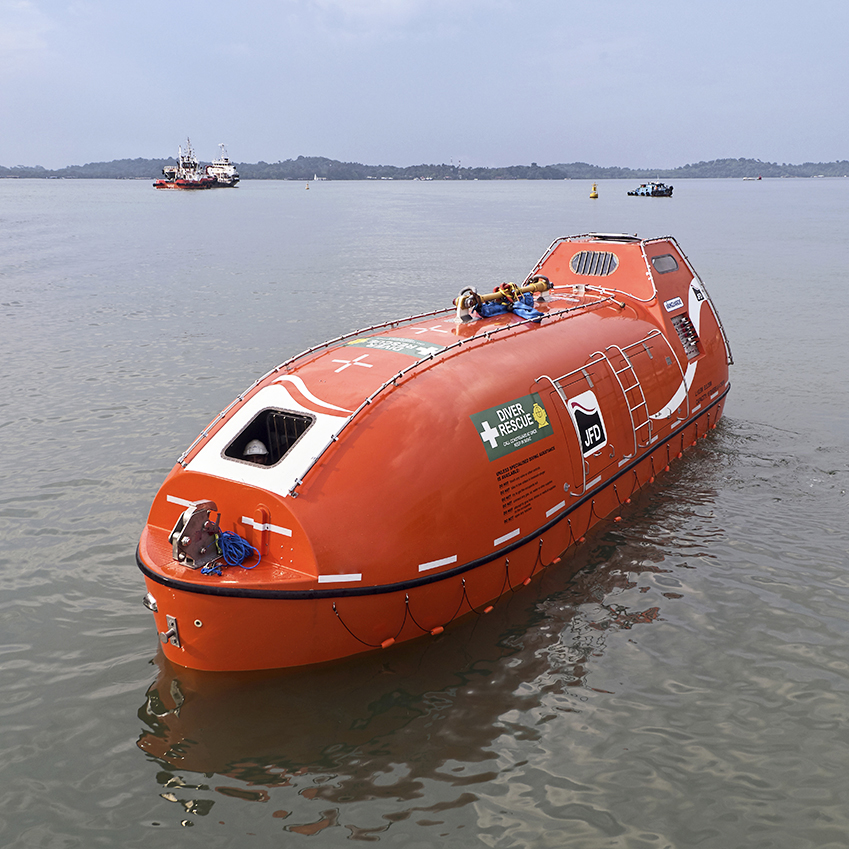A Lifeboat is capable of sustaining the lives of persons in distress from the time a ship is abandoned.
All lifeboats shall be properly constructed and shall have ample stability in a seaway and sufficient freeboard when loaded with their full complement of persons and equipment, and are capable of being safely launched under all conditions of trim of up to 10° and list of up to 20° either way.
There are various types of lifeboats available that have been specifically chosen for the vessel's Operational Requirements:
Open Lifeboats:
- As the name suggests, the open lifeboat has no roof and is normally propelled by manual power such as hand-propelled ores.
- A compression-Ignition engine may also be provided for propulsion purposes.
- Since an Open lifeboat has no roof it is considered the least safe type of lifeboat, as there are no safeguards against water ingress and bad weather.
- The reduced protection inside the open lifeboat makes it harder to maintain and service machinery and equipment.
- It is harder to have fixed electronic communication equipment and an engine.
Closed Lifeboat:
- Closed lifeboats are the most common and popular lifeboats that are used onboard ships.
- They provide a safe environment to the crew against bad weather, cold and strong winds.
The Closed Lifeboats are further classified as
- Partially Enclosed Lifeboats
- Totally Enclosed Lifeboats
Partially Enclosed Lifeboats:
- Partially enclosed lifeboats shall be provided with permanently attached rigid covers extending over not less than 20% of the length of the lifeboat from the stem and not less than 20% of the length of the lifeboat from the aftermost part of the lifeboat.
- The lifeboat shall be fitted with a permanently attached foldable canopy which together with the rigid covers completely encloses the occupants of the lifeboat in a weatherproof shelter and protects them from exposure.
- The lifeboat shall have entrances at both ends and on each side.
- Entrances in the rigid covers shall be weathertight when closed.
- If a partially enclosed lifeboat is fixed with two-way VHF radiotelephone apparatus, it shall be installed in a cabin large enough to accommodate both the equipment and the person using it.
Totally Enclosed Lifeboats:
- A totally-enclosed lifeboat is a lifeboat that is provided with a rigid watertight enclosure that completely encloses the lifeboat. They afford the maximum protection from the elements for their occupants.
- A totally enclosed lifeboat gives more protection to its occupants than open or partially-enclosed lifeboats.
- A totally-enclosed lifeboat is capable of self-righting when loaded with its full or partial complement of persons and equipment assuming all entrances and openings are closed watertight and the persons are secured with safety belts.
Totally-enclosed lifeboats are provided with certain special features which are listed below:
Lifeboats with a Self-Contained air support System:
- A lifeboat with a self-contained support system shall be so arranged that, when proceeding with all entrances and openings closed, the air in the lifeboat remains safe and breathable and the engine runs normally for a period of not less than 10 minutes.
- In case of extreme emergency (vessel on fire), there could be a toxic atmosphere that a lifeboat needs to safely navigate through during this period the self-contained air support system maintains an air pressure slightly above that of the atmosphere outside.
- A self-contained air support system in a lifeboat ensures safe navigation of the boat and prevents toxic air from entering inside.
- As per SOLAS, Chapter III- Life-Saving appliances and arrangements, Section III - Cargo Ships, Regulation 31.1.1.6, Chemical tankers and gas carriers carrying cargoes emitting toxic vapours or gases shall carry totally-enclosed lifeboats with a self-contained air support system.
Fire-Protected Lifeboats:
- A fire-protected lifeboat when waterborne shall be capable of protecting the number of persons it is permitted to carry to accommodate when subjected to a continuous oil fire that envelopes the lifeboat for a period of not less than 8 minutes.
- A fire-protected lifeboat shall be provided with a water spray system that draws the seawater from the sea by means of a self-priming motor pump.
- The primary purpose of this water spray system is to protect the lifeboat from damage from burning oil. Hence it gives boundary cooling to the lifeboat.
- As per SOLAS, Chapter III- Life-Saving appliances and arrangements, Section III - Cargo Ships, Regulation 31.1.1.7, Oil tankers, chemical tankers and gas carriers carrying cargoes having a flashpoint not exceeding 60 degrees Celcius shall carry fire-protected lifeboats.
Free-fall Lifeboats:
- A free-fall lifeboat is a totally enclosed lifeboat that is designed to be launched from a free fall davit.
- Each free-fall lifeboat shall be of sufficient strength to withstand when loaded with its full complement of persons and equipment, a free-fall launch from a height of at least 1.3 times the free-fall certification height.
- A Free-fall lifeboat shall be designed to structurally withstand the forces during launching and when the lifeboat enters into the water.
- Free-fall lifeboats will have their seats positioned facing backwards so that the crew members are facing the door. This arrangement is made to protect the crew members from the impact caused while launching the lifeboats.
- The coxswain's position is often able to rotate so that they can face aft during launching, then turn to face forward for navigation.
Hyperbaric Lifeboats:
- Hyperbaric lifeboats are totally-enclosed lifeboats that contain an integrated hyperbaric chamber, designed for use of divers to enter and exit without undergoing decompression.
- Hyperbaric lifeboats are a highly specialised type of lifeboat that is carried onboard diving vessels for the use of saturation divers.
- Hyperbaric lifeboats are designed to the same lifeboat specifications as totally-enclosed lifeboats, but they have an additional hyperbaric chamber with a life support system designed to sustain their occupants for at least 72 hours.
Reference:
- IMO Publications & Documents - International Codes - LSA Code
- IMO Publications & Documents - Resolutions - Maritime Safety Committee - Resolutions.MSC.48(66).












0 Comments
Thanks for your Valuable comments and Suggestions